Six Rooms for Enrique Vila-Matas
ON RECORD is a series of dialogues with contemporary artists about the ideas and influences that inspire their works. ON RECORD #3 was conducted in Tokyo and edited by ART iT in collaboration with Dominique Gonzalez-Foerster.
I. The Secret Beyond the Door
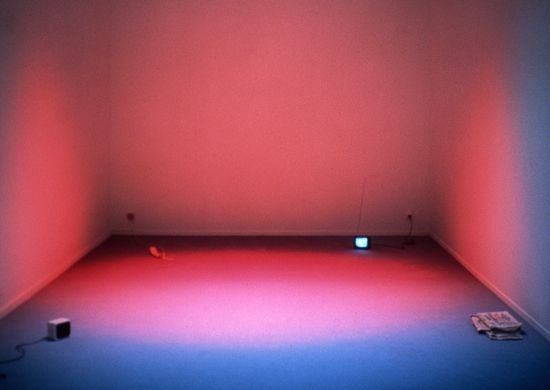 Une Chambre en Ville (1996), carpet, local newspapers bought each day during the exhibition, telephone and telephone connection, mini TV monitor, radio-clock, artificial lighting system. Installation view, ”Dominique Gonzalez-Foerster, Pierre Huyghe, Philippe Parreno“ at ARC/Musée d’art moderne de la ville de Paris, 1998-99. Photo Marc Domage/TUTTI, © the artist, courtesy Jan Mot, Brussels, and Esther Schipper, Berlin.
Une Chambre en Ville (1996), carpet, local newspapers bought each day during the exhibition, telephone and telephone connection, mini TV monitor, radio-clock, artificial lighting system. Installation view, ”Dominique Gonzalez-Foerster, Pierre Huyghe, Philippe Parreno“ at ARC/Musée d’art moderne de la ville de Paris, 1998-99. Photo Marc Domage/TUTTI, © the artist, courtesy Jan Mot, Brussels, and Esther Schipper, Berlin.The books of Enrique Vila-Matas occupy a borderline between fiction and non-fiction writing: they are written in a way that makes you think nothing in them is fiction.
Before he began writing novels, Vila-Matas had a job contributing interviews and articles to a cinema magazine, but he fabricated many of the interviews that he submitted. For example, if he was supposed to interview a certain filmmaker but couldn’t arrange a meeting, he would just make everything up. In many of his texts there are also references to encounters with historical figures like Marcel Duchamp or Marguerite Duras, although when the narrator meets such figures, the way they behave or speak is both very specific and yet not what one might expect.
I remember one day I was with Vila-Matas in a bar in Barcelona, and asked whether he had ever seen Fritz Lang’s film, The Secret Beyond the Door. Vila-Matas replied, “No, I’ve never seen the film, but I met Fritz Lang once.” He said it was at the cinema festival at San Sebastian – something about bumping into Lang in the men’s room. It was difficult at that moment to tell whether this was a true experience or a fiction that had been made up on the spot
In the writing of Vila-Matas there are so many elements that make the fictional convincing, just as in the work of WG Sebald, who would often insert images into his novels in such a way that they act like a reality check: what you assume to be a fiction may in fact be real, but you’re not absolutely sure that it is real because the only source you have is the author’s text. In the case of Vila-Matas, all the names that appear – the street names, the writer names – lure readers into a comfort zone in the sense that much of it is, actually, real.
II. Dublinesca
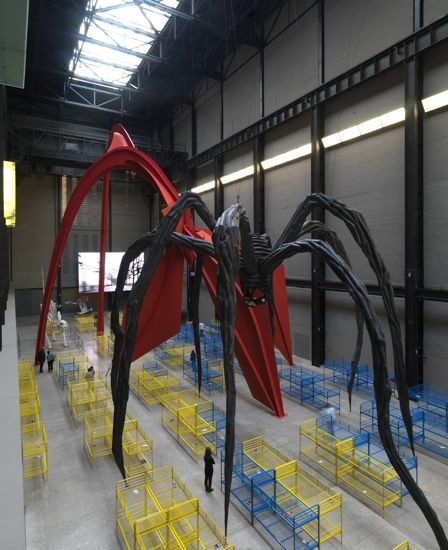 TH.2058 (2008), three reproduced sculptures (125 percent of original size) or six
TH.2058 (2008), three reproduced sculptures (125 percent of original size) or six reproduced sculptures in original size, LED Screen, 229 shakedown beds, approx.
10.000 science-fiction books, sound, approx. 100 x 22 x 20 m. Installation view,
Tate Modern. Photo Tate Photography, London, © Dominique Gonzalez-Foerster.
Vila-Matas’ latest book, Dublinesca, revolves around a publisher who has decided to retire from business and close his catalog. There is a moment in Dublinesca when the publisher says that one of his most interesting reading experiences ever was from a book by the Austrian author, Peter Handke, in which the American film director John Ford is one of the characters. The publisher recounts a scene in the book in which the protagonists are talking and then suddenly John Ford walks over and begins a conversation with them. The publisher says that to have this presence of a real person inserted into a fiction was shocking.
Dublinesca is the first book that Vila-Matas has begun and completed since we have known each other. I observed the process of the book’s writing, or, rather, I was able to follow some of the process. I already knew, for example, that if Vila-Matas decides to do a lecture somewhere, then that experience might end up being incorporated into his next book. But what I have experienced firsthand now is that there is a constant back-and-forth between things Vila-Matas is planning to do in his real life and those that he is planning to write about in his novels, or even things that he plans to do, but doesn’t do, but still includes in his novels.
When I asked him to write a catalog essay for my exhibition “TH.2058” at the Tate Modern Turbine Hall in 2008, I sent him my request by email, and even that became part of Dublinesca. The publisher, who is Vila-Matas, receives an email from “Dominique.” In the email, I described the importance of rain to the concept of the exhibition and its apocalyptic mood. In the novel, this email then connects with the state of mind of the publisher, and rain continues incessantly throughout Dublinesca, just as it does in the scenario I envisioned for my exhibition.
Yet the book is not a diary, which I think could almost be described as passive compared to what Vila-Matas does. This is more an extreme case of writing influencing life and life influencing writing.
III. Travels in the Scriptorium
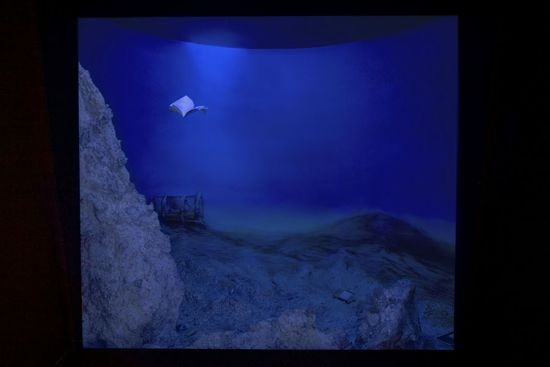 chronotopes & dioramas (2009). Detail view, Dia at the Hispanic Society, Photo Cathy Carver, courtesy the artist and Esther Schipper, Berlin.
chronotopes & dioramas (2009). Detail view, Dia at the Hispanic Society, Photo Cathy Carver, courtesy the artist and Esther Schipper, Berlin.The scripting of a story through referencing events that occur in one’s life, or scripting events in one’s life so that they develop into a story, would only be marginally interesting if it wasn’t connected with a deep knowledge of writing. For Vila-Matas, this switching between his own life and the world of his stories is always mixed with his exploration of the giant library that the world has become. Dublinesca focuses on James Joyce, while París no se acaba nunca focuses on Marguerite Duras, as well as Jorge Luis Borges and some other writers.
Another central character in Dublinesca is the American writer Paul Auster. There is an episode in which the publisher visits Auster at his home, which brought back memories to me of the time in the late 1980s when I was heavily influenced by Auster – I made a work based on his writing – so it’s interesting now to see how these two authors connect.
Auster has entered a difficult phase. His recent book, Travels in the Scriptorium, has somehow managed to relate to his previous writings and characters in a way that suggests a feedback loop. What impresses me about Vila-Matas is that he’s also in a loop, but it’s productive. I have the feeling he is writing one book, that all his books are part of a masterwork, even though these works are able to exist independently of each other in terms of theme, as is the case with Bartleby & Co, about writers who can’t write, and Doctor Pasavento, which is about the opposite, an obsessed reader.
Vila-Matas has reconnected me with literature. He is like a curator, and this is why I think the publisher in Dublinesca is such an important character, and tells so much about him. When Vila-Matas writes about Sebald, Auster, Roberto Bolaño or Franz Kafka, you really want to read these authors. Similarly, Sebald’s approach to writing parallels the way that many visual artists work now: a kind of nonscientific research that creates links between a certain piece of architecture and a certain piece of music, an intuitive research into the world that results in strange findings. Sometimes it’s not so easy to understand the process of making art, how much it involves collecting information and then metabolizing information in a way that goes beyond the academic; it’s almost like the crazy people who invent machines that don’t work.
IV. Dublinesca Revisited: The Gutenberg Galaxy
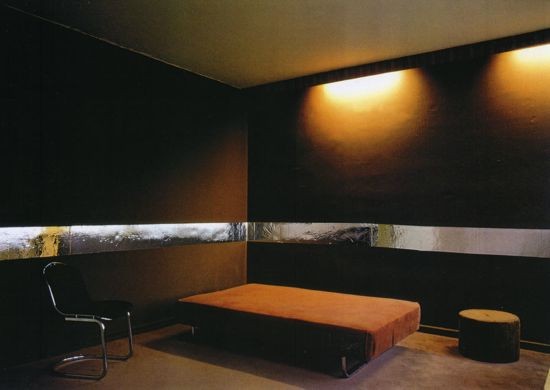 RWF (Rainer Werner Fassbinder) (1993). Installation view, Hohenzollernring 74, Esther Schipper/Michael Krome, Köln. Photo Lothar Schnepf, courtesy Esther Schipper, Berlin.
RWF (Rainer Werner Fassbinder) (1993). Installation view, Hohenzollernring 74, Esther Schipper/Michael Krome, Köln. Photo Lothar Schnepf, courtesy Esther Schipper, Berlin.Regarding the works of Vila-Matas, Sebald or even Borges, you can see there’s a strain of literature that connects deeply to the way the Internet works today. There have been a number of articles on Borges that say he was really the one who envisioned this whole circulation of information: the world as library.
This is something that comes up in Dublinesca when the publisher – confronted with our changing relations to the printed word – contemplates making a requiem for the end of the “Gutenberg Galaxy.” I’m not sure whether this is a term that Vila-Matas found somewhere or invented himself, but here “Gutenberg” refers of course to the first printer and “galaxy” refers to the era of printing. Another theme that emerges is the idea of the hikikomori, understood as the techie recluse who accesses society virtually, a character who travels only in the confines of his room. In the book, the publisher turns into a kind of hikikomori, and over the past two years I have heard Vila-Matas himself use this word frequently. Dublinesca is the first book by Vila-Matas in which he is so conscious about these new media – the Internet, blogs, emails – and I think it is partly related to the fact that Vila-Matas has now developed his personal website into something that is almost a parallel enterprise to his novels.
So the idea – already present in works like Bartleby & Co and Montano’s Malady – that Vila-Matas is investigating literature at a crossroads is more apparent than ever. I must say that when I read his books I always wonder what the experience would be like for someone who has no interest in literature at all. I imagine it’s similar to visiting a completely foreign country where you can’t relate to anything. What becomes clear though is that it’s an endless process: you read something and you quote it and then it gets passed on to someone else and it’s a chain that never stops. Vila-Matas creates a landscape of meanings and encounters, an aesthetic reminiscent of John Cage. There’s one part based on chance but at the same time everything ties together.
The discovery by the publisher in Dublinesca that he has become his catalog of writers, an amalgam of all the writers with whom he has worked, is ultimately a refutation of the closed and stiff notion of identity that has become so tied up in the concept of the author. This multiplicity is something that Borges had already identified, so many years ago, but becomes all the more relevant in the context of the Internet.
V. París no se acaba nunca
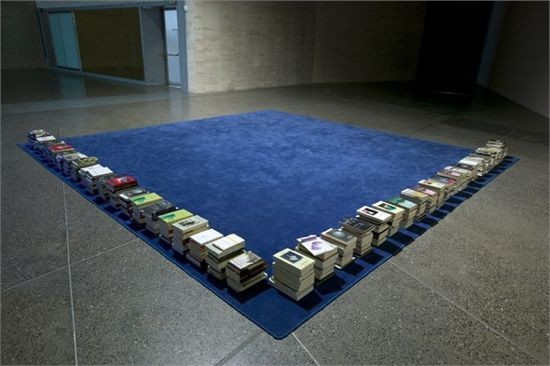 Tapis de Lecture (Enrique Vila-Matas) (2008), one midnight-blue moquette carpet, 300-500 books, dimensions variable. Installation view, Musac – Museo De Arte Contemporaneo De Castilla y Léon. Courtesy Esther Schipper, Berlin.
Tapis de Lecture (Enrique Vila-Matas) (2008), one midnight-blue moquette carpet, 300-500 books, dimensions variable. Installation view, Musac – Museo De Arte Contemporaneo De Castilla y Léon. Courtesy Esther Schipper, Berlin.For a long time I knew of Vila-Matas by name, but never read any of his books, thinking that they would not interest me. Then one day I started reading and was surprised to find out that it was not at all what I had assumed. The first book I read was París no se acaba nunca, which evokes Ernest Hemingway’s A Moveable Feast. In this book Vila-Matas is young and moves to Paris to become a writer, by chance renting a room from Marguerite Duras, who gives him advice. Among other people he meets is the Argentinean writer and filmmaker Edgardo Cozarinsky, who I myself had met a few years before I read the book. Vila-Matas and Cozarinsky meet in a cinema, where Cozarinsky introduces Vila-Matas to Borges’ writings about cinema, and then Vila-Matas goes in search of Borges in Paris.
In 2007 I was invited by Hans Ulrich Obrist to participate in the group show “everstill/siempretodavía,” held in Granada in the former house of the poet Federico García Lorca, and I suggested that we invite Vila-Matas to do a lecture in conjunction with the exhibition. The day I arrived in Granada I happened to check in to the hotel at the exact same time as Vila-Matas: I arrived, he arrived; we were both quite reserved. The next day, we did a long interview with Obrist, all three of us together. And from then on we continued to meet, since Vila-Matas visits Paris quite often.
In 2008 I invited Vila-Matas to Léon for a show I had at MUSAC, “Nocturama*,” and he lectured about Georges Perec, while I made a new reading carpet installation, Tapis de lecture (Enrique Vila-Matas), that was all about Vila-Matas, his books and the books behind his books. Later that year I asked him to contribute an essay to the catalog for my exhibition at the Tate Modern Turbine Hall. When we communicate I use French and he responds in Spanish. So when I wrote to him about Tate I outlined the exhibition concept, which hinged upon the importance of quotations in an end of the world situation. In his reply, Vila-Matas was very enthusiastic about the concept, and basically repeated what I had written about quotations in an end of the world situation, but in a slightly different way. I was energized by his response and wrote him that it was exactly what I had wanted to articulate about the exhibition. It took me a day or two to realize that he had simply translated my ideas into Spanish.
We go back-and-forth like this. We might have a period without correspondence and then suddenly I’ll hear from him, like the time I received a text message out of the blue from Vila-Matas when he was on a trip to Antwerp and found himself in the Antwerp-Centraal train station, the same station that figures prominently at the beginning of Sebald’s Austerlitz.
VI. Vertigo
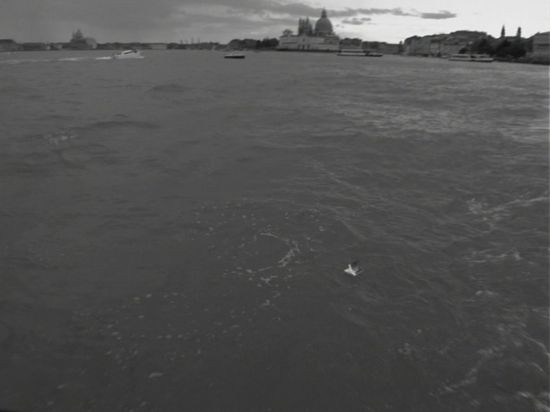 Video still from De Novo (2009), DGF/Corvi-Mora production, DVD, duration 20 min, French with subtitles, filmed on location in Venice. Courtesy the artist and Esther Schipper, Berlin.
Video still from De Novo (2009), DGF/Corvi-Mora production, DVD, duration 20 min, French with subtitles, filmed on location in Venice. Courtesy the artist and Esther Schipper, Berlin.My earliest installations, the “chambres/rooms” were adapted from novels and were an attempt to create narratives without text. When I started the “rooms” I was reading detective novels, like those by David Goodis, and one of the first installations is based on a Goodis novel. I had this idea of the clue as a correspondence between an object and a linguistic system, a kind of double articulation. I envisioned the installations as three-dimensional texts in which visitors could draw their own connections between different elements.
Although I’ve never been tempted to adapt a book into a film, literature is central to the work I made for the 53rd Venice Biennale in 2009, De Novo. In this film there is a scene in which I am riding the Vaporetto and I throw a book into the lagoon. When my daughter saw the film she was terribly concerned that we would never be able to recover the book. She asked me whether I had written my name in the book. I said no. Then she asked which book it was. I replied that it was Vertigo, by Sebald. She thought momentarily before saying, “If it’s Vertigo, then it’s ok.”
To that extent the action with the book was quite provocative; it was not easy to perform. Of course I love books, they have always been an essential building material for my practice, and any exhibition that I do could almost be reduced to 10 or 20 titles. But at the same time I’m a kind of failed writer, and as much as I love books there is a tension there: it has always been a mystery to me as to how one writes fiction, how to start, what to write about.
An Abridged Vila-Matas Reader:
Paul Auster
Roberto Bolaño
Jorge Luis Borges
Eduardo Cozarinsky
Marguerite Duras
Peter Handke
Ernest Hemingway
James Joyce
Franz Kafka
Claudio Magris
Georges Perec
WG Sebald
Enrique Vila-Matas
